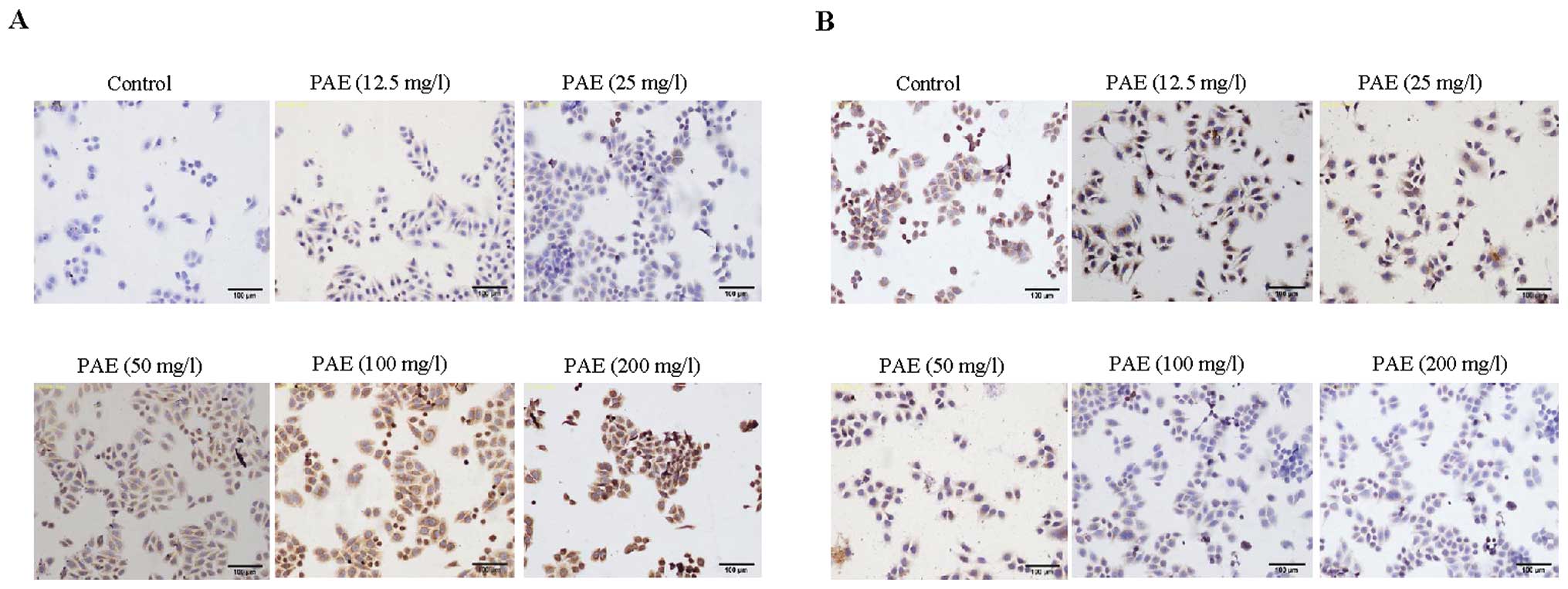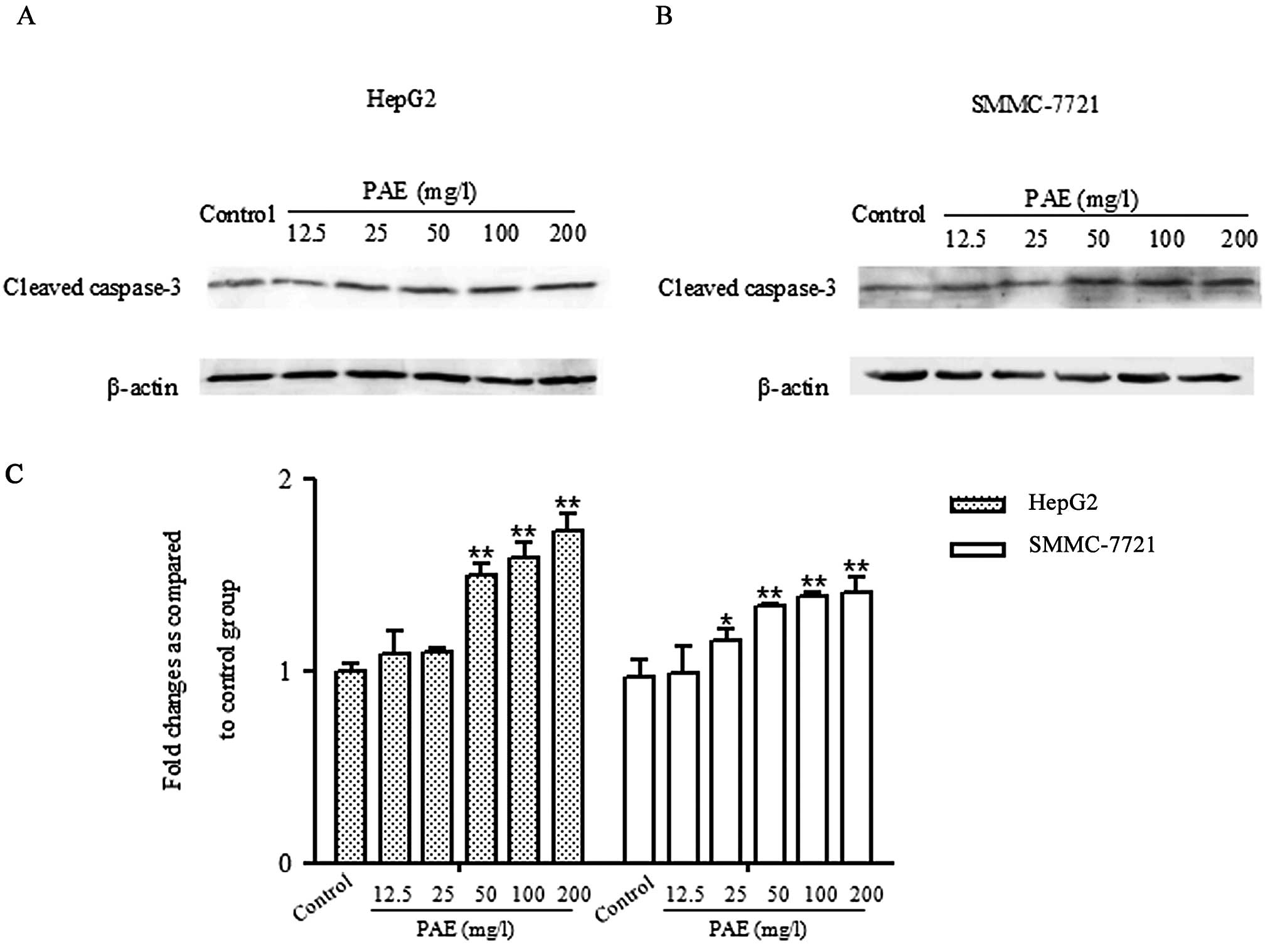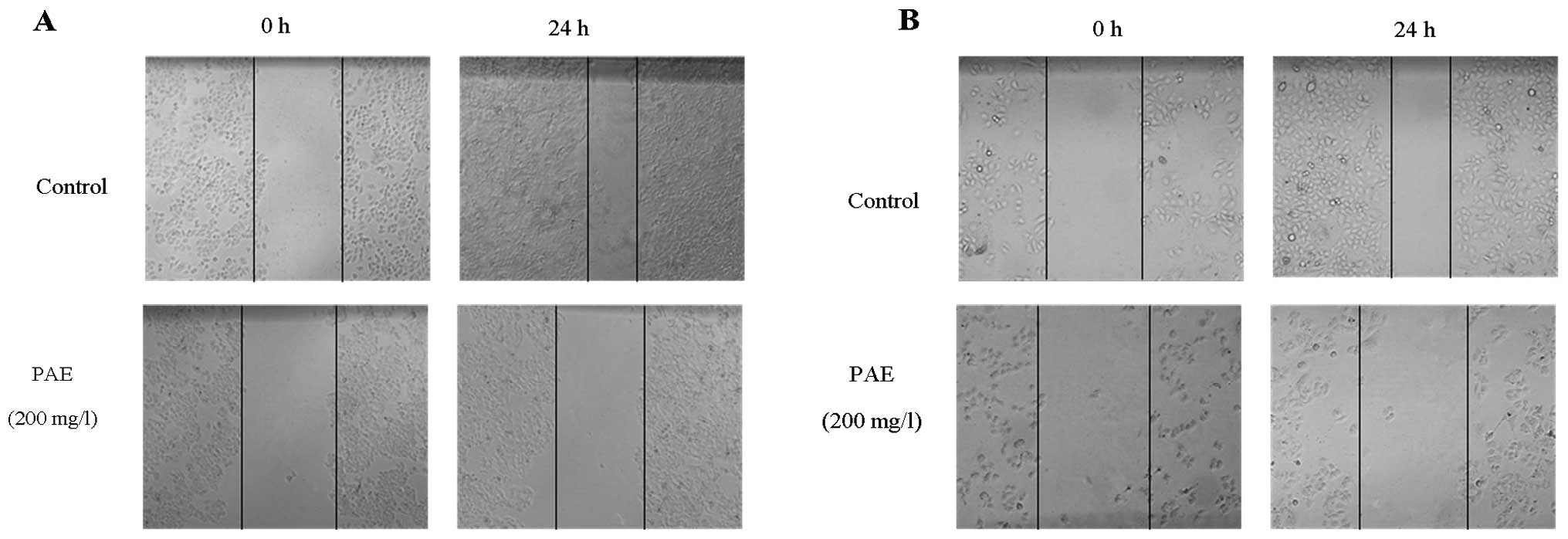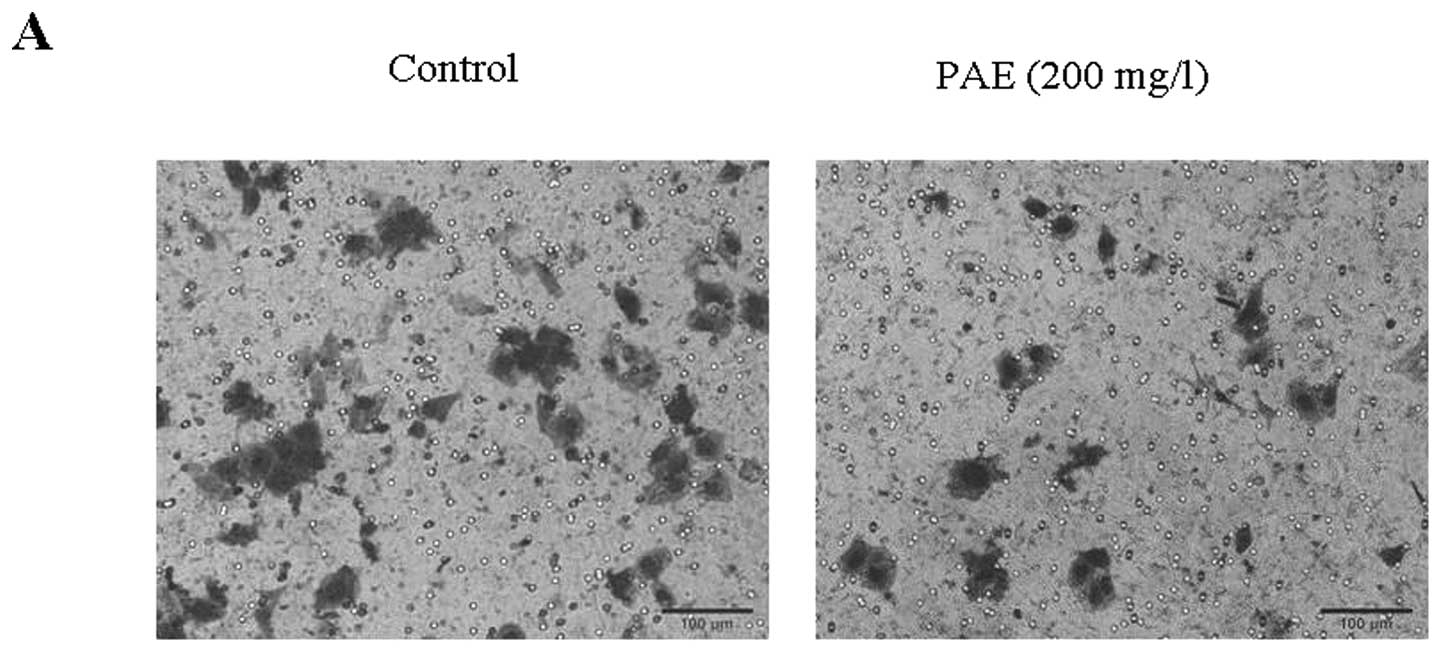|
1.
|
El-Serag HB and Rudolph KL: Hepatocellular
carcinoma: epidemiology and molecular carcinogenesis.
Gastroenterology. 132:2557–2576. 2007. View Article : Google Scholar : PubMed/NCBI
|
|
2.
|
Yang JD and Roberts LR: Hepatocellular
carcinoma: a global view. Nat Rev Gastroenterol Hepatol. 7:448–458.
2010. View Article : Google Scholar : PubMed/NCBI
|
|
3.
|
He J, Gu D, Wu X, et al: Major causes of
death among men and women in China. N Engl J Med. 353:1124–1134.
2005. View Article : Google Scholar : PubMed/NCBI
|
|
4.
|
Villanueva A and Llovet JM: Targeted
therapies for hepatocellular carcinoma. Gastroenterology.
140:1410–1426. 2011. View Article : Google Scholar : PubMed/NCBI
|
|
5.
|
Ma L, Wen S, Zhan Y, He Y, Liu X and Jiang
J: Anticancer effects of the Chinese medicine matrine on murine
hepatocellular carcinoma cells. Planta Med. 74:245–251. 2008.
View Article : Google Scholar : PubMed/NCBI
|
|
6.
|
Wang S, Zheng Z, Weng Y, et al:
Angiogenesis and anti-angiogenesis activity of Chinese medicinal
herbal extracts. Life Sci. 74:2467–2478. 2004. View Article : Google Scholar : PubMed/NCBI
|
|
7.
|
Dai LM, Chen MZ and Xu SY: Protective
effects of total glucocides of paeony on experimental hepatitis.
Chinese Pharmacol Bull. 9:449–453. 1993.
|
|
8.
|
Wang H, Wei W, Wang NP, et al: Effects of
total glucosides of peony on immunological hepatic fibrosis in
rats. World J Gastroenterol. 11:2124–2129. 2005. View Article : Google Scholar : PubMed/NCBI
|
|
9.
|
Zheng YQ and Wei W: Total glucosides of
paeony suppresses adjuvant arthritis in rats and intervenes
cytokine-signaling between different types of synoviocytes. Int
Immunopharmacol. 5:1560–1573. 2005. View Article : Google Scholar : PubMed/NCBI
|
|
10.
|
Wang SH, Wei W, Xu DJ and Cui Y:
Proliferation inhibition and mechanism of TGP on HepG2 cell in
vitro. Acta Universitatis Medicinalis Anhui. 41:547–549. 2006.
|
|
11.
|
Wang SH, Wei W, Xu DJ, Xu SP and Cui Y:
Proliferation inhibition of TGP on SMMC-7721 Cell in vitro. Anhui
Med Pharmaceut J. 10:8–9. 2006.
|
|
12.
|
Zhang L and Zhang S: Modulating Bcl-2
family proteins and caspase-3 in induction of apoptosis by
paeoniflorin in human cervical cancer cells. Phytother Res.
25:1551–1557. 2011. View
Article : Google Scholar : PubMed/NCBI
|
|
13.
|
Wu H, Li W, Wang T, Shu Y and Liu P:
Paeoniflorin suppress NF-kappaB activation through modulation of I
kappaB alpha and enhances 5-fluorouracil-induced apoptosis in human
gastric carcinoma cells. Biomed Pharmacother. 62:659–666. 2008.
View Article : Google Scholar
|
|
14.
|
Tsuboi H, Hossain K, Akhand AA, et al:
Paeoniflorin induces apoptosis of lymphocytes through a
redox-linked mechanism. J Cell Biochem. 93:162–172. 2004.
View Article : Google Scholar : PubMed/NCBI
|
|
15.
|
Zhang Q, Gao WY and Man SL: Chemical
composition and pharmacological activities of astragali radix.
Zhongguo Zhong Yao Za Zhi. 37:3203–3207. 2012.(In Chinese).
|
|
16.
|
Law PC, Auyeung KK, Chan LY and Ko JK:
Astragalus saponins downregulate vascular endothelial growth
factor under cobalt chloride-stimulated hypoxia in colon cancer
cells. BMC Complement Altern Med. 12:1602012. View Article : Google Scholar
|
|
17.
|
Hu XY, Xia RX, Cheng CB, et al: Mechanism
of apoptosis in human leukemia NB4 cells induced by total
astragalosides. Zhonghua Zhong Liu Za Zhi. 33:345–348. 2011.(In
Chinese).
|
|
18.
|
Liu X, Yang Y, Zhang X, et al: Compound
Astragalus and Salvia miltiorrhiza extract inhibits
cell invasion by modulating transforming growth factor-beta/Smad in
HepG2 cell. J Gastroenterol Hepatol. 25:420–426. 2010.
|
|
19.
|
Nishiyama N, Wang YL and Saito H:
Beneficial effects of S-113m, a novel herbal prescription, on
learning impairment model in mice. Biol Pharm Bull. 18:1498–1503.
1995. View Article : Google Scholar : PubMed/NCBI
|
|
20.
|
Sun WY, Wei W, Wu L, Gui SY and Wang H:
Effects and mechanisms of extract from Paeonia lactiflora
and Astragalus membranaceus on liver fibrosis induced by
carbon tetrachloride in rats. J Ethnopharmacol. 112:514–523.
2007.PubMed/NCBI
|
|
21.
|
Shao FR, Wei W, Liu H, et al: Comparison
of protective effect of Shaoqiduogan extracted by different methods
on immunological liver injury in mice. J Anhui TCM College.
26:21–24. 2007.
|
|
22.
|
Sun WY, Wei W, Gui SY, Wu L and Wang H:
Protective effect of extract from Paeonia lactiflora and
Astragalus membranaceus against liver injury induced by
bacillus Calmette-Guerin and lipopolysaccharide in mice. Basic Clin
Pharmacol Toxicol. 103:143–149. 2008.
|
|
23.
|
Colombo M, de Franchis R, Del Ninno E, et
al: Hepatocellular carcinoma in Italian patients with cirrhosis. N
Engl J Med. 325:675–680. 1991. View Article : Google Scholar : PubMed/NCBI
|
|
24.
|
Paradis V: Histopathology of
hepatocellular carcinoma. Recent Results Cancer Res. 190:21–32.
2013. View Article : Google Scholar : PubMed/NCBI
|
|
25.
|
Zhang XY and Wang J: A study on the
chemical constituents of Paeonia lactiflora Pall. J Shenyang
Pharmaceutl Univ. 18:30–32. 2001.
|
|
26.
|
Rahbari NN, Mehrabi A, Mollberg NM, et al:
Hepatocellular carcinoma: current management and perspectives for
the future. Ann Surg. 253:453–469. 2011. View Article : Google Scholar : PubMed/NCBI
|
|
27.
|
Alves RC, Alves D, Guz B, et al: Advanced
hepatocellular carcinoma. Review of targeted molecular drugs Ann
Hepatol. 10:21–27. 2011.
|
|
28.
|
Yu YL, Lu Y, Tang X and Cui FD:
Formulation, preparation and evaluation of an intravenous emulsion
containing Brucea javanica oil and Coix Seed oil for
antitumor application. Biol Pharm Bull. 31:673–680. 2008.
View Article : Google Scholar : PubMed/NCBI
|
|
29.
|
Li WY, Chiu LC, Lam WS, et al: Ethyl
acetate extract of Chinese medicinal herb Sarcandra glabra
induces growth inhibition on human leukemic HL-60 cells, associated
with cell cycle arrest and up-regulation of pro-apoptotic Bax/Bcl-2
ratio. Oncol Rep. 17:425–431. 2007.PubMed/NCBI
|
|
30.
|
Luqman S and Pezzuto JM: NFkappaB: a
promising target for natural products in cancer chemoprevention.
Phytother Res. 24:949–963. 2010.PubMed/NCBI
|
|
31.
|
Karikas GA: Anticancer and chemopreventing
natural products: some biochemical and therapeutic aspects. J BUON.
15:627–638. 2010.PubMed/NCBI
|
|
32.
|
You N, Liu W, Wang T, et al: Swainsonine
inhibits growth and potentiates the cytotoxic effect of paclitaxel
in hepatocellular carcinoma in vitro and in vivo.
Oncol Rep. 28:2091–2100. 2012.PubMed/NCBI
|
|
33.
|
Hu S, Sun W, Wei W, et al: Involvement of
the prostaglandin E receptor EP2 in paeoniflorin-induced human
hepatoma cell apoptosis. Anticancer Drugs. 24:140–149. 2013.
View Article : Google Scholar : PubMed/NCBI
|
|
34.
|
Sun WY, Wang L, Liu H, Li X and Wei W: A
standardized extract from Paeonia lactiflora and
Astragalus membranaceus attenuates liver fibrosis induced by
porcine serum in rats. Int J Mol Med. 29:491–498. 2012.
|
|
35.
|
Thompson HJ, Strange R and Schedin PJ:
Apoptosis in the genesis and prevention of cancer. Cancer Epidemiol
Biomarkers Prev. 1:597–602. 1992.PubMed/NCBI
|
|
36.
|
Giannattasio A, Angeletti G, De Rosa M, et
al: RNA expression bcl-w, a new related protein Bcl-2 family and
caspase-3 in isolated sertoli cells from pre-pubertal rat testes. J
Endocrinol Invest. 25:C23–C25. 2002. View Article : Google Scholar : PubMed/NCBI
|
|
37.
|
Adams JM and Cory S: The Bcl-2 protein
family: arbiters of cell survival. Science. 281:1322–1326. 1998.
View Article : Google Scholar : PubMed/NCBI
|
|
38.
|
Cory S and Adams JM: The Bcl2 family:
regulators of the cellular life-or-death switch. Nat Rev Cancer.
2:647–656. 2002. View
Article : Google Scholar : PubMed/NCBI
|
|
39.
|
Barille-Nion S, Bah N, Vequaud E and Juin
P: Regulation of cancer cell survival by BCL2 family members upon
prolonged mitotic arrest: opportunities for anticancer therapy.
Anticancer Res. 32:4225–4233. 2012.PubMed/NCBI
|
|
40.
|
Zeng H, Kong X, Peng H, et al: Apoptosis
and Bcl-2 family proteins, taken to chronic obstructive pulmonary
disease. Eur Rev Med Pharmacol Sci. 16:711–727. 2012.PubMed/NCBI
|
|
41.
|
Kinoshita M, Eguchi Y and Hynynen K:
Activation of Bak in ultrasound-induced, JNK- and p38-independent
apoptosis and its inhibition by Bcl-2. Biochem Biophys Res Commun.
353:515–521. 2007. View Article : Google Scholar : PubMed/NCBI
|
|
42.
|
Galluzzi L, Kepp O and Kroemer G:
Caspase-3 and prostaglandins signal for tumor regrowth in cancer
therapy. Oncogene. 31:2805–2808. 2012. View Article : Google Scholar : PubMed/NCBI
|
|
43.
|
Porter AG and Janicke RU: Emerging roles
of caspase-3 in apoptosis. Cell Death Differ. 6:99–104. 1999.
View Article : Google Scholar : PubMed/NCBI
|
|
44.
|
Zhu S, Cohen MB, Bjorge JD, Mier JW and
Cho DC: PI3K inhibition potentiates Bcl-2-dependent apoptosis in
renal carcinoma cells. J Cell Mol Med. 17:377–385. 2013. View Article : Google Scholar : PubMed/NCBI
|
|
45.
|
Lin HI, Lee YJ, Chen BF, et al:
Involvement of Bcl-2 family, cytochrome c and caspase 3 in
induction of apoptosis by beauvericin in human non-small cell lung
cancer cells. Cancer Lett. 230:248–259. 2005. View Article : Google Scholar : PubMed/NCBI
|
|
46.
|
Tao YM, Liu Z and Liu HL: Dickkopf-1
(DKK1) promotes invasion and metastasis of hepatocellular
carcinoma. Dig Liver Dis. 45:251–257. 2013. View Article : Google Scholar : PubMed/NCBI
|
|
47.
|
Korpi JT, Hagstrom J, Lehtonen N, et al:
Expression of matrix metalloproteinases-2, -8, -13, -26 and tissue
inhibitors of metalloproteinase-1 in human osteosarcoma. Surg
Oncol. 20:e18–e22. 2011. View Article : Google Scholar : PubMed/NCBI
|
















